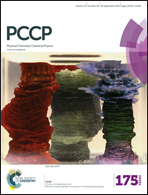Ultra-weak interlayer coupling in two-dimensional gallium selenide†
Abstract
Beyond-graphene two-dimensional (2D) materials are envisioned as the future technology for optoelectronics, and the study of group IIIA metal monochalcogenides (GIIIAMMs) in 2D form is an emerging research field. Bulk gallium selenide (GaSe) is a layered material of this family which is widely used in nonlinear optics and is promising as a lubricant. The interlayer coupling in few-layer GaSe is currently unknown, and the stability of different polytypes is unclear. Here we use symmetry arguments and first-principles calculations to investigate the phase stability, interlayer coupling, and the Raman and infrared activity of the low-frequency shear and breathing modes expected in few-layer GaSe. Strategies to distinguish the number of layers and the β and ε polytypes are discussed. These symmetry results are valid for other isostructural few-layer GIIIAMM materials. Most importantly, by using a linear chain model, we show that the shear and breathing force constants reveal an ultra-weak interlayer coupling at the nanoscale in GaSe. These results suggest that β and ε few-layer GaSe show similar lubricant properties to those observed for few-layer graphite. Our analysis opens new perspectives about the study of interlayer interactions and their role in the mechanical and electrical properties of these new 2D materials.



 Please wait while we load your content...
Please wait while we load your content...